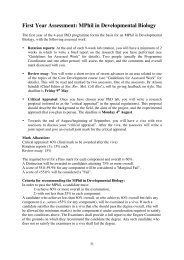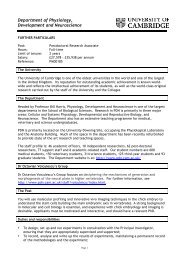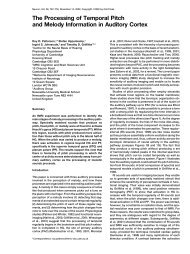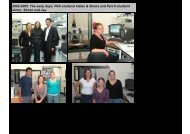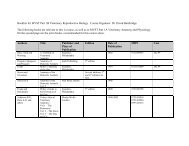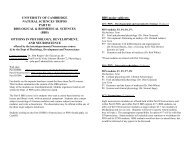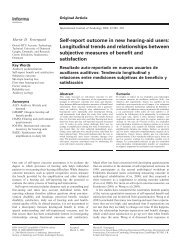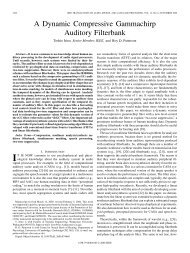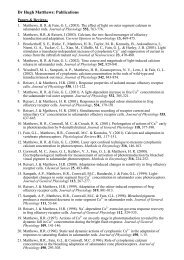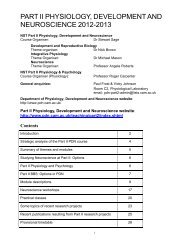StochSim: modelling of stochastic biomolecular processes
StochSim: modelling of stochastic biomolecular processes
StochSim: modelling of stochastic biomolecular processes
Create successful ePaper yourself
Turn your PDF publications into a flip-book with our unique Google optimized e-Paper software.
BIOINFORMATICS APPLICATIONS NOTE<br />
Vol. 17 no. 6 2001<br />
Pages 575–576<br />
STOCHSIM: <strong>modelling</strong> <strong>of</strong> <strong>stochastic</strong> <strong>biomolecular</strong><br />
<strong>processes</strong><br />
Nicolas Le Novère ∗ and Thomas Simon Shimizu<br />
Department <strong>of</strong> Zoology, University <strong>of</strong> Cambridge, Downing Street,<br />
Cambridge CB2 3EJ, UK<br />
Received on November 11, 2000; revised on February 27, 2001; accepted on March 1, 2001<br />
ABSTRACT<br />
Summary: STOCHSIM is a <strong>stochastic</strong> simulator for chemical<br />
reactions. Molecules are represented as individual<br />
s<strong>of</strong>tware objects that react according to probabilities derived<br />
from concentrations and rate constants. Version 1.2<br />
<strong>of</strong> STOCHSIM provides a novel cross-platform graphical<br />
interface written in Perl/Tk. A simple two-dimensional<br />
spatial structure has also been implemented, in which<br />
nearest-neighbour interactions <strong>of</strong> molecules in a 2-D<br />
lattice can be simulated.<br />
Availability: Various ports <strong>of</strong> the program can be retrieved<br />
at ftp://ftp.cds.caltech.edu/pub/dbray/<br />
Contact: nl223@cus.cam.ac.uk; tss26@cam.ac.uk<br />
STOCHSIM ALGORITHM<br />
Most available biochemical simulators are deterministic,<br />
i.e. they use a set <strong>of</strong> differential equations to represent the<br />
reactions and solve the system iteratively by numerical<br />
integration. Such programs include, for instance, Gepasi<br />
(Mendes and Kell, 1998), Jarnac (Sauro, 2000) and DB-<br />
Solve (Goryanin et al., 1999). However, the assumptions<br />
made by the deterministic method do not hold true for<br />
many intracellular <strong>processes</strong> which are sensitive to the<br />
behaviour <strong>of</strong> a relatively small number <strong>of</strong> molecules. The<br />
<strong>stochastic</strong> behaviour <strong>of</strong> the component molecules must<br />
then be considered.<br />
Stochastic simulation <strong>of</strong> biochemical reactions was pioneered<br />
by Gillespie, who developed an efficient algorithm<br />
for this purpose (Gillespie, 1976). But, as with conventional<br />
deterministic methods, the Gillespie method treats<br />
molecular species in bulk and does not represent individual<br />
molecules separately. This can be a problem when a<br />
system contains proteins that have multiple modification<br />
sites which alter their catalytic activity, binding affinity<br />
and so on. Each state may have different reactive properties<br />
and a detailed model may contain millions <strong>of</strong> distinct<br />
chemical reactions. Both the deterministic method and the<br />
Gillespie method, in which the time required for simula-<br />
∗ To whom correspondence should be addressed.<br />
tion increases proportionally with the number <strong>of</strong> reactions,<br />
have difficulty in coping with these conditions.<br />
In STOCHSIM, each molecule exists as an independent<br />
s<strong>of</strong>tware object. This allows the representation<br />
<strong>of</strong> molecules that have specific internal states, called<br />
multistate molecules. These react with different probabilities<br />
according to the state they are in, and are<br />
used to reflect intramolecular events such as covalent<br />
modification or conformational changes. The state <strong>of</strong><br />
a multistate molecule can change over the course <strong>of</strong><br />
a simulation as a result <strong>of</strong> the defined reactions. This<br />
individual representation allows more accurate <strong>modelling</strong><br />
<strong>of</strong> biochemical <strong>processes</strong> at the cost <strong>of</strong> higher memory<br />
and CPU consumption. See Morton-Firth and Bray (1998)<br />
and STOCHSIM manual (Le Novère et al., 2000) for<br />
an in-depth discussion <strong>of</strong> the relative efficiency <strong>of</strong> the<br />
algorithms used by Gillespie and STOCHSIM.<br />
STOCHSIM reduces all possible reactions to elementary<br />
unimolecular and bimolecular reactions. The probabilities<br />
<strong>of</strong> all reactions are precomputed based on user-specified<br />
rate constants, and stored in a look-up table during initialisation.<br />
The length <strong>of</strong> time that each simulation iteration<br />
represents, as well as the probability <strong>of</strong> unimolecular<br />
and bimolecular reactions occuring within each iteration,<br />
are also adjusted during initialisation to ensure correct reaction<br />
rates. Once these have been set up, the simulation<br />
proceeds by iteration <strong>of</strong> a very simple subroutine in which<br />
either a unimolecular or a bimolecular reaction can occur<br />
between randomly chosen molecules.<br />
TkSTOCHSIM<br />
The original STOCHSIM simulator was written for Micros<strong>of</strong>t<br />
Windows and was provided with a Graphical User<br />
Interface (GUI) based on the Micros<strong>of</strong>t MFC widgets.<br />
These widgets were not compatible with other operating<br />
systems such as UNIX, Linux, or MacOS. Therefore to<br />
run STOCHSIM under such operating systems, the user<br />
was required to write the simulation initialisation files<br />
manually. This is tedious and error-prone. In order to ease<br />
the creation and modification <strong>of</strong> simulation configurac○<br />
Oxford University Press 2001 575
N.Le Novère and T.S.Shimizu<br />
tions under a variety <strong>of</strong> operating environments, a novel<br />
interface written in Perl using the Tk widgets has been<br />
developed. Not all <strong>of</strong> the functionalities <strong>of</strong> STOCHSIM<br />
are currently covered. In particular, the configuration<br />
<strong>of</strong> dynamic values have yet to be implemented. The<br />
configuration <strong>of</strong> models using the novel spatial extensions<br />
to STOCHSIM (see next paragraph) are also not supported<br />
yet. To access these functions <strong>of</strong> STOCHSIM, the user can<br />
directly write the configuration files. However, once the<br />
configuration files are written, TkSTOCHSIM can read<br />
and run any simulation and display the results.<br />
SPATIAL EXTENSIONS TO STOCHSIM<br />
STOCHSIM 1.0 treated the entire reaction system as<br />
a uniformly mixed solution. The omission <strong>of</strong> spatial<br />
heterogeneity has been a norm in biochemical simulations<br />
because it greatly facilitates <strong>modelling</strong> and reduces<br />
the computational load <strong>of</strong> simulation. However, as the<br />
resolution <strong>of</strong> our understanding <strong>of</strong> biochemical <strong>processes</strong><br />
increases, it is becoming clear that the spatial organisation<br />
<strong>of</strong> molecules <strong>of</strong>ten play an important role. We have<br />
therefore undertaken extending STOCHSIM to incorporate<br />
a spatial representation.<br />
In the current version (STOCHSIM 1.2), a simple twodimensional<br />
spatial representation has been implemented,<br />
in which multistate molecules are treated as probabilistic<br />
cellular automata. Nearest-neighbour interactions between<br />
molecules in a lattice (such as clustered receptors on<br />
a membrane) can be defined to simulate the effect <strong>of</strong><br />
spatial interactions. This was motivated by studies <strong>of</strong> the<br />
bacterial chemotaxis receptor complex which suggested<br />
that lateral interactions between neighbouring complexes<br />
exist (Shimizu et al., 2000). Similar clustering behaviour<br />
has also been observed for other receptors (Yin and Lai,<br />
2000).<br />
In STOCHSIM 1.2’s 2-D complex array, reactions that<br />
are sensitive to the state <strong>of</strong> neighbouring complexes can<br />
be defined. The rates <strong>of</strong> these reactions depend not only<br />
on the state <strong>of</strong> the complex chosen in the STOCHSIM<br />
iteration, but also on the states <strong>of</strong> its nearest neighbours<br />
within the complex array. Graphical snapshots <strong>of</strong> the state<br />
<strong>of</strong> the complex array, as well as traces <strong>of</strong> the state <strong>of</strong><br />
individual complexes within the array can be outputted at<br />
user-specified intervals.<br />
IMPLEMENTATION<br />
The STOCHSIM simulation engine is written in C ++ , and<br />
has been successfully compiled under Windows95/98 as<br />
well as Linux (2.2) running on Alpha and Intel (x86) chips.<br />
The Perl/Tk interface requires at least Perl 5.004 and<br />
Perl/Tk 800.022. It has been tested under Windows 98 and<br />
Debian GNU/Linux Slink, Potato and Woody.<br />
REFERENCES<br />
Gillespie,D.T. (1976) A general method for numerically simulating<br />
the <strong>stochastic</strong> time evolution <strong>of</strong> coupled chemical reactions. J.<br />
Comput. Phys., 22, 403–434.<br />
Goryanin,I., Hodgman,T.C. and Selkov,E. (1999) Mathematical<br />
simulation and analysis <strong>of</strong> cellular metabolism and regulation.<br />
Bioinformatics, 15, 749–758.<br />
Le Novère,N., Shimizu,T.S., Firth,C. and Bray,D. (2000)<br />
STOCHSIM, the <strong>stochastic</strong> simulator. ftp://ftp.cds.caltech.<br />
edu/pub/dbray/.<br />
Mendes,P. and Kell,D.B. (1998) Non-linear optimization <strong>of</strong> biochemical<br />
pathways: applications to metabolic engineering and<br />
parameter estimation. Bioinformatics, 14, 869–883.<br />
Morton-Firth,C.J. and Bray,D. (1998) Predicting temporal fluctuations<br />
in an intracellular signalling pathway. J. Theor. Biol., 192,<br />
117–128.<br />
Sauro,H. (2000) Jarnac: an interactive metabolic systems language.<br />
http://www.members.tripod.co.uk/sauro/Jarnac.htm.<br />
Shimizu,T.S., Le Novère,N., Levin,M.D., Beavil,A.J., Sutton,B.J.<br />
and Bray,D. (2000) Molecular model <strong>of</strong> a lattice <strong>of</strong> signalling<br />
proteins involved in bacterial chemotaxis. Nat. Cell Biol., 2, 792–<br />
796.<br />
Yin,C.C. and Lai,A.F. (2000) Intrinsic lattice formation by the<br />
ryanodine receptor calcium-release channel. Nat. Cell Biol., 2,<br />
669–671.<br />
576



